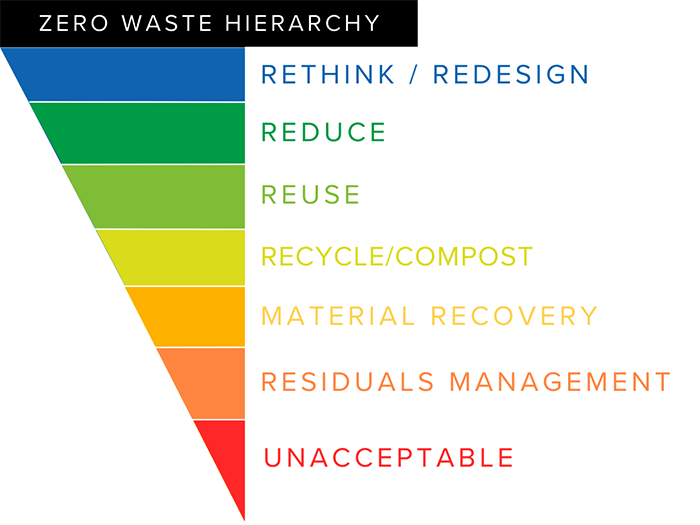Closing the Loop: Reducing Waste Through the Zero Waste Hierarchy

Exclusively sponsored by Honeycomb Strategies.
Creating beautiful events requires a lot of materials, but the costs of sourcing and disposing of these can impact both the budget and the environment. For eco-conscious planners, aiming for zero waste is a popular goal, with certifications like TRUE Zero Waste rewarding sustainable efforts.
One useful tool for reducing event waste is the Zero Waste Hierarchy from the Zero Waste International Alliance. This chart classifies waste from most to least desirable, considering the entire lifecycle of items. It’s beneficial for individuals, businesses, waste managers, lawmakers and event planners alike. To be able to understand and use the hierarchy, we’re breaking it down step by step to show its utility in planning an event.

Rethink/Redesign
To tackle excess waste and resource depletion, producers must create a new system for material use, including rethinking our dependency on physical items. In a circular economy, we opt for traded, found, recycled, upcycled or previously harvested materials. This approach challenges traditional notions of product ownership, promoting sharing or communal ownership. Though these concepts can be uncomfortable departures from our norms, it’s essential to envision sustainable alternatives.
When planning events, prioritize the value of the experience over material aspects. Attendees will remember the connections and shared knowledge more than the materials of their water glass or the floor coverings of an expo hall. This focus allows event planners to make environmentally friendly choices, sometimes eliminating materials altogether.
The 3 Rs: Reduce, Reuse, Recycle
The next three tiers of the hierarchy are reduction, reuse and recycling or composting, listed from most to least impactful. While thought of as sustainable solutions, recycling and composting still have environmental impacts and perpetuate the current harmful supply chain, and depending on where you are, different municipal infrastructures may limit recycling options.
The Zero Waste International Alliance emphasizes mindful consumption through planning, whether we’re talking about meal prep or gift bag pre-orders. Reducing means ordering fewer items or choosing less toxic materials. Reuse promotes a circular economy by keeping goods in circulation, reducing the need for virgin resources and disposal impacts. For events, reuse can apply to signage, décor, swag and exhibition materials.
Material Recovery and Residuals Management
The next two steps are designed to capture and rescue materials from landfill. Some items can be salvaged for reclamation, a process that uses scraps in engineering projects. Residuals management shores up environmental protections to minimize toxic leaks into the environment such as ground water contamination or noxious gas burn-off. Importantly, both of these steps direct us back to the top of the hierarchy, asking us to evaluate what items still remain in the waste stream and asking if they can be eliminated from production upstream. These steps are largely stop-gap measures implemented at waste disposal sites, but events can support them with thorough waste management plans that include sorting.
Unacceptable
This category includes perpetuating a system of overuse, over extraction and temporality of material goods, and forbids incineration or chemical processing of waste items. Unfortunately, many of our default systems of purchase-use-disposal fall into this category, so to avoid unacceptable waste, we must work against inertia. Event planners can perform due diligence in talking with their host venues and waste haulers about disposal options and can make detailed, actionable plans to prevent the bulk of their event discards from qualifying as unacceptable.
It's essential that early and frequent communication between the event team, venue, contractor, exhibitors (if applicable) and event attendees include education and guidance on waste management. Since event planners can’t possibly control all waste production, there must be a collective effort to achieve goals within a defined framework. The Zero Waste Hierarchy can help teams measure purchasing and disposal habits against a sustainable metric by focusing on the “highest and best use” of items. By cutting costs and prioritizing connection over material goods, zero waste principles can lead events to more efficient, higher value experiences.
Honeycomb Strategies specializes in impactful solutions for sustainable events, sports and venues. hcsustainability.com /hello@hcsustainability.com


Add new comment